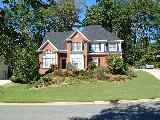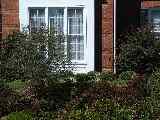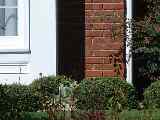Fuji FinePix 4900 ZoomFujifilm extends its consumer digicam, with a 6x optical zoom lens and extensive exposure controls.<<Reference: Datasheet :(Previous) | (Next): Print-Friendly Review Version>> FinePix 4900 Zoom Sample ImagesReview First Posted: 10/7/2000 |
| We've begun including links in our reviews to a Thumber-generated index page for our test shots. The Thumber data includes a host of information on the images, including shutter speed, ISO setting, compression setting, etc. Rather than clutter the page below with *all* that detail, we're posting the Thumber index so only those interested in the information need wade through it! ;) |
|
|
Outdoor portrait: (1647k) The extreme tonal range of this image makes it a tough shot for many digicams, which is precisely why we set it up this way. The object is to hold highlight and shadow detail without producing a "flat" picture with muddy colors, and the Fujifilm FinePix 4900 Zoom's white balance system performs reasonably well. Given that we were shooting with a prototype model of the camera, we won't be hypercritical of its color balance performance. (Which was quite good, nonetheless.) We shot samples of this image in the automatic (1653k), daylight (1647k) and manual (1633k) white balance modes, choosing the manual setting for our main series because it produced the most accurate color (though just a touch warm). Both the automatic and daylight settings appear very similar, and slightly cool. Though this is a prototype digicam, the overall color balance looks about right. The blue pants and flowers are almost dead-accurate (these blues are somewhat difficult for many digicams to reproduce correctly), and the skin tones and hair color also look good. Resolution looks pretty good too, although just a little bit soft. A fair amount of fine detail exists throughout the image, with the shadow areas showing slightly less detail. A moderate amount of noise is present in the shadow areas as well. Our main image was taken with a +0.3 EV exposure adjustment, which did the best job of adequately exposing the shadow areas without blowing out the highlights. The table below shows the results of a range of exposure settings from zero to +1.3 EV in the manual white balance mode. Exposure Compensation Settings:
|
|||||||||||||||||||||
|
|
Closer portrait: (1630k) The F4900 also does a great job with this closer, portrait shot, thanks in part to its 6x lens. (Shorter focal length lenses tend to distort facial features in close-up shots like this and the availability of longer focal lengths is a key feature if you're going to be shooting close-up people shots.) Continuing with the manual white balance mode, we shot our main image with no exposure compensation adjustment at all. (This close-up shot generally requires less exposure compensation than the wider angle Outdoor Portrait.) Resolution and detail look sharper and crisper than in the Outdoor shot, especially in the strands of the model's hair. A moderate amount of fine-grained noise remains in the shadow areas, however. The skin tones are a little yellow/reddish, but that could be due to the camera's preproduction status. The table below shows the results of a range of exposure settings on the F4900, from zero to +1.0 EV. Exposure Compensation Settings:
|
|||||||||||||||||||||
|
|
Indoor Portrait, Flash: (1676k) The FinePix 4900 Zoom's internal flash did an excellent job of illuminating the subject in this test. There's a slight magenta cast to the shot, due to the heavy color cast of the bright incandescent room lighting, but the color is overall very good. We experimented a bit with the variable flash power option on the camera, with very nice results. We shot exposures with the flash set at nominal exposure (1665k), +0.3 EV,(1676k) and +0.6EV.(1674k) We chose the +0.6EV shot for our main one for this category, but they all looked quite nice. The F4900 also has a top-mounted "hot shoe" for attaching
an external flash. Again, we experimented only briefly with this
(reserving further experimentation for a final production unit),
but did manage to get this (1657k)
exceptionally evenly-exposed shot, albeit with considerable
color cast from the room lighting. For this shot, we aimed the flash
at the ceiling and held a white paper in front of it, between the
flash and the model. This both diffused some light directly toward
the model, and bounced a goodly portion off the white wall behind
us. The result is lighting so even that its hard to tell where the
light sources are. We perhaps should have used a gel on the flash
and then set the camera's white balance to incandescent, but found
that a one-click "Auto Levels" operation in Photoshop
cleaned the image up incredibly and produced one of the nicest shots
we've taken of this test, as seen here.(1676k)
|
|||||||||||||||||||||
|
|
Indoor portrait, no flash: (1660k) This shot is always a very tough test of a camera's white balance capability, given the strong, yellowish color cast of the household incandescent bulbs used for the lighting, and the DC3400's white balance system did an excellent job. We tested the automatic (1675k), incandescent (1683k) and manual (1660k) white balance settings, choosing manual for our main series. Automatic white balance resulted in a very yellowish cast, while the incandescent setting left a bit of a greenish tint in the picture. The manual white balance setting resulted in beautifully colored images. We ran a series of test shots, with exposure compensation ranging from 0 to +1.5 EV, and chose the +0.6EV shot (1660k) as our main one for this category. The skin tones are a little ruddy, and the yellow flower is a bit muddy, but overall the color balance is among the best we've seen for this shot. (To quantify a bit, probably in the top 5% of all cameras we've tested.) Exposure Compensation Settings:
|
|||||||||||||||||||||
|
|
House shot: (1716k) NOTE that this is the "new" house shot, a much higher-resolution poster than we first used in our tests. To compare the image of the F4900 with previously tested cameras, here's a shot of the original house poster in the automatic,(1717k) daylight,(1722k) and manual (1741k) white balance setting. We shot samples of this image with the automatic,(1716k) daylight,(1778k) and manual (1733k) white balance modes, choosing the automatic setting for our main image. The daylight setting produced very warm results, as did the manual setting, which also seemed slightly overexposed. We picked up a slight reddish tint with the automatic setting, but chose it as the most accurate overall. Resolution again is a bit of a mixed bag: There's a tremendous amount of detail visible, as seen in the tree limbs, shrubbery, and bricks, but the image overall is a bit soft. It's important to note this difference between detail and sharpness: The D4900 uses a SuperCCD sensor, and interpolates more than cameras with conventional CCDs do. Thus, the images tend to look soft on-screen, but when reduced to print at the same size as images from cameras with conventional CCDs with the same number of photo sites will generally be at least as sharp, if not sharper. - A conundrum for those of us accustomed to looking at things on the computer: Take the time to download and print out these images before forming any conclusions on sharpness! A moderate amount of fine grain noise shows up in the roof shingles and the shadow areas, though it isn't too bothersome. In-camera sharpening is practically undetectable (we just picked up about a pixel of the halo effect around the light and dark edges of the white trim along the roof line). |
|||||||||||||||||||||
|
|
Far-Field Test (1759k) This image is shot at infinity to test far-field lens performance. NOTE that this image cannot be directly compared to the other "house" shot, which is a poster, shot in the studio. The rendering of detail in the poster will be very different than in this shot, and color values (and even the presence or absence of leaves on the trees!) will vary in this subject as the seasons progress. In general though, you can evaluate detail in the bricks, shingles and window detail, and in the tree branches against the sky. Compression artifacts are most likely to show in the trim along the edge of the roof, in the bricks, or in the relatively "flat" areas in the windows. We shot this image with the automatic white balance setting, as it produced a very accurate white value, with nice color balance throughout the image. This shot is a strong test of detail, given the practically infinite range of fine detail viewable from a distance. Resolution is reasonably good, but again just slightly soft (evidenced by the pine needles and tree branches against the sky, as well as the bricks and shrubbery). Once again though, we caution readers to actually print these images to make their comparisons, as the printed versions look surprisingly sharp & detailed. We also judge a camera's dynamic range in this shot, comparing how well the camera holds detail in both the shadow and highlight areas. The F4900 has just a little bit of trouble holding detail in the very bright bay window area, but the shadow areas fare much better, as the dark shadow beneath the cherry tree on the right side of the house shows pretty good detail. Noise is moderately low in the roof shingles and shadow areas, with a very fine grain. We also snapped images at the 125,(1690k) 200,(1718k) 400,(1675k) and 800 (1681k) ISO settings, noticing that the exposure became slightly darker with each increase in sensitivity. Noise level increased somewhat with the higher ISO settings, but remained fairly moderate and tolerable up until the ISO 400 setting. Noise level becomes much more obtrusive at the ISO 800 setting. We also noticed that as the ISO level increased, so did the amount of visible detail in the bay window. The table below shows the full resolution and quality series.
Sharpness Series We also shot a series with the camera's sharpness adjustment, which seemed to alter saturation just slightly. The Hard setting seemed to just barely undersaturate the red bricks, while the soft setting increased saturation a little.
|
|||||||||||||||||||||
|
|
Lens Zoom Range We've received a number of requests from readers to take shots showing the lens focal length range of those cameras with zoom lenses. Thus, we're happy to present you here with the following series of shots, showing the field of view with the lens at full wide angle, the lens at full 6x telephoto and the lens at full telephoto with 3.75x digital telephoto enabled. The full wide angle setting shows just a hint of barrel distortion, but captures a nice, large area with good resolution. The 6x telephoto does a great job of zooming in, producing a nice crisp image, but with a slightly dimmer exposure (doubtless the result of the meter being fooled a bit by the bright white trim on the house. We were impressed with the performance of the 3.75x digital zoom, which maintains a nice level of image quality and reasonably sharp resolution. (Note that all these images were shot at the minimum 640x480 resolution, which makes the digital telephoto function much more like a conventional optical telephoto, given that it's just cropping out the central portion of the CCD's image anyway.)
|
|||||||||||||||||||||
|
|
Musicians Poster (1720k) We shot samples of this target using the automatic,(1700k) daylight,(1699k) and manual (1720k) white balance settings. The automatic setting produced a reddish image, possibly being tricked by the overwhelming amount of blue in the image. Daylight white balance produced nearly accurate results, though a slight magenta cast is present. The manual setting seemed to produce the best color and white balance, though we again noticed that the exposure is a little brighter than the other two settings. Despite the camera's prototype status, color balance looks pretty good throughout the image, judging by each of the models' skin tones and the difficult blue of the Oriental model's robe. Resolution looks pretty good throughout as well, with a fair amount of detail visible in the bird wings and silver threads on the blue robe (the subtle color gradations on the wings are just barely visible). The flower garland, violin strings, and beaded necklaces also show a reasonable amount of detail. Again, a moderate amount of noise is present in the blue background and shadow areas, and is just perceptible in the faces. |
|||||||||||||||||||||
|
|
Macro Shot (2295k) Coming Soon! |
|||||||||||||||||||||
|
|
"Davebox" Test Target (1637k) We shot samples of this target using the automatic,(1648k) daylight,(1657k) and manual (1637k) white balance settings, again choosing the manual setting for our main shot. The automatic and daylight settings resulted in similar images, both showing a warm, reddish cast. We again noticed a slightly brighter exposure with the manual setting, but the white of the mini-resolution target looked the most accurate. Color balance is quite good overall, but slightly muted on the large cyan, magenta, and yellow swatches of the MacBeth(tm) target. (For some reason, many digicams tend to undersaturate these "subtractive primary" colors.) The F4900 distinguishes between the red and magenta color blocks on the middle, horizontal color chart, which is a tough area for many digicams. The subtle tonal variations of the Q60 chart are just barely visible up to the "B" range, showing that the image is a little overexposed (another common problem area for digicams). The tonal gradations of the vertical gray scales are also distinguishable across their full range, though the two very darkest blocks blur together a bit. A fair amount of detail is visible in the shadow area of the briquettes, as well as in the highlight areas of the white gauze. Noise is moderate in the manual white balance setting, but seems to be less prevalent in the other two white balance modes. |
|||||||||||||||||||||
|
|
Low-Light Tests Due to the F4900 Zoom's prototype status, we did not shoot a series of Low-Light shots. We will measure the F4900's low-light capabilities when the production model is available for testing. |
|||||||||||||||||||||
|
|
Flash Range Test (This test was added in August 1999, so cameras tested before that time won't have comparison pictures available. As we go forward though, all the new models will have similar tests available). Fujifilm rates the F4900's flash as effective from 0.9 to 14.7 feet (0.3 to 4.5m), which doesn't quite match our test results. We found the F4900's flash to be the brightest (though a little dim) at the eight foot mark. The flash power and intensity steadily decreased from there, becoming very dim at the 13 foot mark. Below is our flash range series, with distances from eight to 13 feet from the target. We'd rate flash range at only 10 feet or so, but once again, this is a prototype camera, so the production models may do a little better.
|
|||||||||||||||||||||
|
|
ISO-12233 (WG-18) Resolution Test (1725k) The FinePix 4900 Zoom did a good job in our resolution test: For now, we didn't run our standard rule resolution series, but instead shot examples of the resolution target at the 2400 x 1800 (1725k) and 1600 x 1200 (835k) resolution sizes, both at the fine quality and wide angle settings. The larger image shows resolution of 850 lines per picture height in the horizontal direction, and 800 lines per picture height vertically, but there's clear detail visible to at least 950 horizontally and 900 vertically, albeit with some aliasing. At the 1600x1200 size, resolution is about 600 lines per picture height in both directions, and there are more "jaggies" visible in the image. Thus, while purists may object to the greater amount of interpolation Fuji's SuperCCD cameras use at their highest resolution settings, the images in that mode clearly contain more detail and fewer artifacts than smaller images made from the same data in-camera. (And, although we didn't show it here, a brief experiment resampling the images in Photoshop post-capture also lost significant detail relative to the original 2400 x 1800 shots.) Overall, a very good performance. |
|||||||||||||||||||||
|
|
Viewfinder Accuracy/Flash Uniformity We found the F4900's LCD monitor to be pretty accurate, showing about 98 percent accuracy at wide angle (267k), and about 94.5 percent at the telephoto (276k) setting (at all four image sizes). Since we generally like to see LCD monitors as close to 100 percent accuracy as possible, the F4900 does an excellent job. Optical distortion on the F4900 is rather high at both ends of its zoom range. We measured 1.29 percent barrel distortion at the wide angle end, and 0.67 pincushion distortion at the telephoto end. Both numbers are higher than average among digicams we've tested, although in fairness, most digicams only have 3x zoom lenses. Chromatic aberration is relatively low, showing only two or three pixels of coloration on each side of the black target lines. (This distortion is visible as a very slight colored fringe around the objects at the edges of the field of view on the resolution target.) Flash distribution looks fairly even at the wide angle setting, with some falloff around the corners. We didn't measure flash intensity with the telephoto setting, as the flash power was too weak at that distance from the target (thanks to the long 6x zoom lens) and we were forced to use our studio lights. |
|||||||||||||||||||||




Follow Imaging Resource: